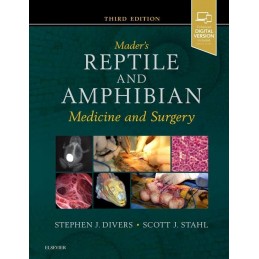- Reduced price

Order to parcel locker

easy pay


 Delivery policy
Delivery policy
Choose Paczkomat Inpost, Orlen Paczka, DHL, DPD or Poczta Polska. Click for more details
 Security policy
Security policy
Pay with a quick bank transfer, payment card or cash on delivery. Click for more details
 Return policy
Return policy
If you are a consumer, you can return the goods within 14 days. Click for more details
Known as the bible of herpetological medicine and surgery, Maders Reptile and Amphibian Medicine and Surgery, 3rd Edition edited by Stephen Divers and Scott Stahl provides a complete veterinary reference for reptiles and amphibians, including specific sections on practice management and development; taxonomy, anatomy, physiology, behavior, stress and welfare; captive husbandry and management including nutrition, heating and lighting; infectious diseases and laboratory sciences; clinical techniques and procedures; sedation, anesthesia and analgesia; diagnostic imaging; endoscopy; medicine; surgery; therapy; differential diagnoses by clinical signs; specific disease/condition summaries; population health and public health; and legal topics. Well-organized and concise, this new edition covers just about everything related to reptiles and amphibians by utilizing an international array of contributing authors that were selected based on their recognized specialization and expertise, bringing a truly global perspective to this essential text!
Data sheet
Section 1: Practice Management & Development
1. Reptile Practice Management
2. Reference Resources for the Reptile Clinician
3. Understanding the Human-Reptile Relationship
4. Veterinary Specialization
5. The Importance of Herpetological Publication by Clinicians and Academics
6. Statistics for the Clinician
Section 2: Biology (Taxonomy, Anatomy, Physiology and Behavior)
7. Taxonomy, Anatomy and Physiology of Tortoises, Turtles and Terrapins
8. Taxonomy, Anatomy and Physiology of Snakes
9. Taxonomy, Anatomy and Physiology of Lizards
10. Taxonomy, Anatomy and Physiology or Crocodilians
11. Taxonomy, Anatomy and Physiology of Tuataras
12. Taxonomy, Anatomy and Physiology of Amphibians
13. Natural Behaviors
14. Conditioning and Behavioral Training
15. Stress and Welfare of Reptiles and Amphibians
Section 3: Husbandry and Management
16. General Husbandry and Management of Reptiles
17. Environmental Lighting
18. Disinfection
19. Quarantine
20. Snakes
21. Lizards
22. Management of Venomous Species
23. Tortoises, Freshwater Aquatic Turtles and Terrapins
24. Sea Turtles
25. Crocodilians
26. Tuatara
27. Nutrition
28. General Husbandry and Management of Amphibians
Section 4: Infectious Diseases and Laboratory Sciences
29. Bacteriology
30. Virology
31. Mycology
32. Parasitology Including Hemoparasites
33. Hematology
34. Clinical Chemistry
35. Hematology and Biochemistry Tables
36. Molecular Diagnostics
37. Immunopathology
38. Cytology
39. Biopsy
40. Necropsy
41. Commercial and Analytical Labs
Section 5: Techniques and Procedures
42. Handling and Physical Examination
43. Diagnostic Techniques and Sample Collection
44. Catheter Placement
45. Esophogastric Feeding Tube Placement
46. Hospitilization
47. Euthanasia
Section 6: Anesthesia
48. Sedation
49. General Anesthesia
50. Analgesia
51. Regional Anesthesia and Analgesia
52. Amphibian Anesthesia
Section 7: Diagnostic Imaging
53. Radiography - General Principles
54. Radiography - Lizards
55. Radiography - Snakes
56. Radiography - Chelonians
57. Radiography - Crocodilians
58. Ultrasonography
59. Computed Tomography
60. Magnetic Resonance Imaging
61. Scintigraphy
Section 8: Endoscopy
62. Diagnostic and Surgical Endoscopy Equipment
63. Endoscopy practice management and marketing
64. Diagnostic Endoscopy
65. Endoscope-Assisted and Endoscopic Surgery
Section 9: Medicine
66. Urology
67. Hepatology
68. Cardiology
69. Dermatology I (Skin)
70. Dermatology II (Shell)
71. Ophthalmology
72. Otorhinolaryngology
73. Gastroenterology I (Oral cavity, esophagus, stomach)
74. Gastroenterology II (Small and large intestines)
75. Gastroenterology III (Cloaca)
76. Pulmonology
77. Neurology
78. Oncology
79. Endocrinology
80. Theriogenology
81. Musculoskeletal
82. Vascular, Hematopoietic Immunology
83. Clinical Behavioral Medicine
84. Nutritional Diseases
85. Perinatology
86. Geriatrics
87. Emergency and Critical Care
88. Toxicology
89. Amphibian Medicine Overview
Section 10: Surgery
90. Surgical Equipment, Instrumentation and General Principles
91. Eye
92. Ear
93. Rhinarium
94. Oral Cavity
95. Venemoid surgery
96. Integument - Skin
97. Coeliotomy - Snake
98. Coeliotomy - Lizard
99. Prefemoral Coeliotomy - Chelonian
100. Transplastron Coeliotomy - Chelonian
101. Coeliotomy - Crocodilian
102. Respiratory Tract
103. Gastro-Intestinal Surgery
104. Urinary Tract
105. Reproductive Tract
106. Cloacal Surgery
107. Amphibian Soft Tissue Surgery
108. External Coaptation
109. Fracture Fixation
110. Spinal Sugery
111. Limb Amputation
112. Tail Amputation
113. Shell Surgery and Repair
Section 11: Therapy
114. Therapeutic Overview and General Approach
115. Routes of Administration
116. Antibiotic Therapy
117. Antifungal Therapy
118. Antiviral Therapy
119. Anti-Inflammatory Therapy
120. Anti-Parasitic Therapy
121. Mental Health Treatment
122. Nutritional Therapy
123. Chemotherapy
124. Radiation Therapy
125. Miscellaneous Drug Therapy
126. Allometric Scaling
127. Reptile Formulary
128. Amphibian Formulary
129. Low Level LASER Therapy
130. Wound Management
131. Rehabilitation and Physical Therapy
132. Alternative and Complimentary Therapies
Section 12: Differential Diagnosis by Clinical Signs
133. Snakes
134. Lizards
135. Chelonians
136. Crocodilians
137. Amphibians
Section 13: Specific Disease/ Case Summary
138. Abscesses
139. Acariasis
140. Regurgitiation and Vomiting
141. Aural Abscess
142. Bites and Prey-Induced Trauma
143. Cloacal Prolapse
144. Cryptosporidiosis (Lizards)
145. Cryptosporidiosis (Snakes)
146. Urolithiasis (cystic calculi, cloacal uroliths)
147. Diarrhea
148. Digit Abnormalities
149. Dysecdysis
150. Dystocia
151. Gout
152. Hemoparasites
153. Hepatic Lipidosis
154. Herpesviruses of Tortoises
155. Hyperglycemia
156. Hyper and Hypovitaminosis A
157. Inclusion Body Disease
158. Secondary Nutritional Hyperparathyroidism
159. Neurologic Disorders
160. Paramyxoviruses
161. Periodontal Disease
162. Pneumonia
163. Pseudogout
164. Renal Disease
165. Shell Damage
166. Salmonellosis
167. Spinal Osteopathy
168. Tail Damage
169. Thermal Burns
170. Stomatitis
171. Scent Gland Adenitis
172. Mycoplasmosis and Upper Respiratory Tract Disease
173. Chytridiomycosis
Section 14: Population and Public Health
174. Zoonoses and Public Health
175. Working With Free-Ranging Reptiles
176. Medical Management and Rehabilitation of Sea Turtles
177. Commercial Reptile Farming
178. Large Zoo and Private Collection Management
179. Breeders, Wholesale and Retail
180. Laboratory Reptile and Amphibian Management
181. Conservation Issues
182. Herpetofauna and Ecosystem Health
Section 15: Legal Topics
183. International Legislation
184. European Legislation
185. US Federal Legislation
186. Forensics
187. Jurisprudence, Expert Reports, Testimony and Court Appearance
Reference: 79729
Author: Fergus Shanahan
Reference: 16227
Author: C. Torrente Artero
Seria ''Szybka informacja kliniczna''
